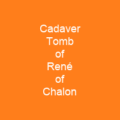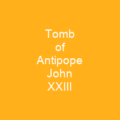The Cadaver Tomb of René of Chalon: A Memento Mori in Stone
Imagine a time when death wasn’t just an abstract concept but a tangible presence, embodied in stone and marble. The Cadaver Tomb of René of Chalon, a late Gothic masterpiece, stands as a haunting reminder of this era. Located in the church of Saint-Étienne at Bar-le-Duc, France, it is more than just a tomb; it’s a silent narrative of mortality and the fleeting nature of life.
The Story Behind the Stone
René of Chalon, Prince of Orange, died in 1544 at the age of 25 during the siege of St. Dizier. His untimely death, marked by a wound sustained in battle, left his widow Anna of Lorraine with an enduring grief and a desire to honor her beloved husband. Could it be that she commissioned this tomb as a memento mori, a poignant reminder of their shared mortality? The exact details remain uncertain, but the monument stands as a testament to René’s life and Anna’s love.
A Living Corpse in Stone
The Cadaver Tomb itself is a striking piece. Ligier Richier, the sculptor, presented René as an écorché, with his skin and muscles decayed, leaving him reduced to a skeleton. The left arm is raised as if gesturing towards heaven, a gesture that has sparked much debate among art historians. What did it originally hold? A heart, a symbol of love, or perhaps something more profound?
The tomb consists of an altarpiece and a limestone statue of a putrefied and skinless corpse standing upright with its left hand outwards. The altarpiece is made from black carved marble and limestone, measuring 267 cm x 592 cm (105 in x 233 in). Its top-slab is taken from the former tomb of Henry IV, Count of Bar (d. 1344) and Yolande of Flanders (d. 1395).
Restoration and Replicas
The Cadaver Tomb has undergone extensive restoration between 1998 and 2003, including the removal of graffiti and replacement of iron fasteners with stainless steel studs. Replicas of the statue are in various museums, ensuring that René’s legacy lives on. One replica at the Palais de Chaillot was produced in 1894, while another by François Pompon stands as a tribute to the playwright and poet Henry Bataille at Moux.
Symbolism and Meaning
The tomb is remarkable for its original presentation of a ‘living corpse’ motif. Art historians debate this particular example’s meaning, specifically the symbolism of the raised hand and what it originally held. Interpretations include a dedication commissioned by a loving wife, the inevitability and effect of death, despair or a romantic ideal of the eternal spirit, or a mark of penance.
The mural on the wall behind the statue was painted by Varembel Barber in 1790, adding another layer to this complex monument. The first literary reference to the transi appears in Louis Des Masures’ 1557 Epitaph on the Heart of René de Chalon, Prince of Orange.
A Monumental Legacy
The Cadaver Tomb of René of Chalon was designated as a Monument historique in 1898. It has been moved several times—originally placed over a vault in the collegiate church of Saint-Maxe, then moved to St Étienne and later to Paris during World War I. The tomb suffered damage due to humidity and water contact, leading to restoration works from 1969 onwards.
The statue and altarpiece underwent further restoration between 1998 and 2003, including the removal of graffiti and replacement of iron fasteners with stainless steel studs. The tomb was later assessed and repaired, with notable discoveries of decorations on its mural during the restoration process.

The Cadaver Tomb is more than just a historical artifact; it’s a profound reflection on the human condition. As we stand before this silent sentinel, we are reminded that life, though fleeting, leaves an indelible mark on our world.
Will you visit the Cadaver Tomb of René of Chalon and reflect on its timeless message?
You want to know more about Cadaver Tomb of René of Chalon?
This page is based on the article Cadaver Tomb of René of Chalon published in Wikipedia (retrieved on March 11, 2025) and was automatically summarized using artificial intelligence.







